Botanical Beach: In the footsteps of Josephine Tilden and the historic Minnesota Seaside Station
 | 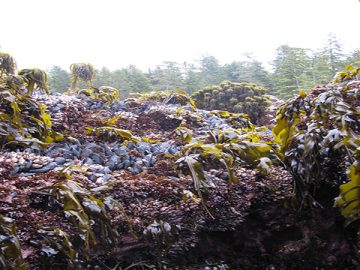  |
| Dates: | July 26-28, 2018 (Registration deadline: June 1, 2018) |
| Cost: | CAD$260 (Maximum 20 participants) |
| Organizers: | Tom Mumford, University of Washington, tmumford@u.washington.edu Paul Gabrielson, University of North Carolina, drseaweed@hotmail.com |
| Price includes: | • Round trip van and ferry travel from UBC to Port Renfrew, BC • Two nights accommodation at the Big Fish Lodge • Two intertidal forays and a visit to the remains of the historic Minnesota Seaside Station, established in 1899 • Two lunches (Friday and Saturday) and one dinner (Friday) |
| Description: | This field trip will be to one of the most spectacular rocky intertidal beaches in North America. Paul Gabrielson and Tom Mumford will lead the trip. Tom has been studying and leading field trips there since 1970; Paul since 1975. Botanical Beach was first brought to the attention of the world of phycology when Dr. Josephine Tilden of the University of Minnesota, after traveling up and down the west coast, concluded this was the location for the study of marine algae and established a marine station at the site in 1899. The Minnesota Seaside Station operated for 7 years. Two issues of the journal “Postelsia” were published on the work done there. As you will see, she chose well. The field trip will include hikes through the forest where the Minnesota Seaside Station was founded, and two intertidal forays, where Dr. Tilden brought students and researchers to study seaweeds, ecology, geology of the West Coast. Tom will provide an evening lantern show of photos of the Minnesota Seaside Station to help you appreciate what it took to be a female scientist starting a marine station in what was a very remote location. The intertidal zone at Botanical Beach is exposed to the full force of the NE Pacific Ocean. We will see/touch/fondle the iconic kelp Postelsia palmaeformis and the surf-loving Lessoniopsis littoralis, and more than hundred other species of algae. We will also explore the algae in highly-diverse sheltered coves, as well as in the famous tide pools. And the inverts are just as spectacular as the algae! For those of you who learned about keystone species, this location is about as close as you will get to Paine’s famous Tatoosh Island site in terms of biota, zonation, and exposure- Postelsia, mussel beds, and Pisaster in striking zonation. Tom can provide a short explanation with real props! The second day will feature a hike about 1 km to the east to the Devil’s Billiard Table, a fascinating area of sandstone concretions and benches, coastal rain forest and a bog. This is a field trip requiring stamina and good balance. The hike into the beach is about 1km, elevation gain/loss is about 100m. The rocky intertidal zone is steep, uneven, slippery, and requires extra caution, especially if there is any surf. The area is a BC Provincial Park, and there is absolutely no collecting of any specimens allowed. Bring your camera, and if you have a waterproof one, the tidepools provide some amazing underwater shots. We will be eager to help you identify the local seaweeds, and will have copies for sale of the 2018 updated "Keys to the Seaweeds and Seagrasses of Southeast Alaska, British Columbia, Washington and Oregon". |
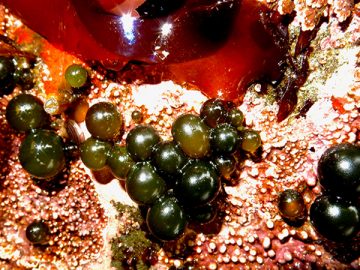 | 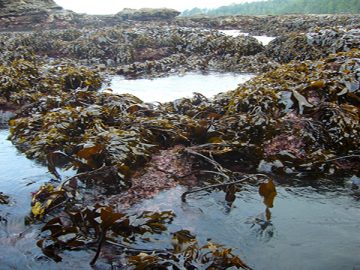  |
| Logistics: | Thursday, July 26, 2017 Leave UBC (meet in front of Mahoney’s Bar, University Ave) in 8-person vans at approximately 11:00 AM. Drive to Tsawwassen and catch the 1:00 PM ferry to Swartz Bay, then drive for approximately two hours to Port Renfrew along the southwest coast of Vancouver Island, arriving about 6pm. We be staying in the beautiful Big Fish Lodge. Room assignments and room sharing TBD. We will enjoy dinner together at the local pub (at your own expense). If desired, you are responsible for bringing your own alcohol. Friday, July 27, 2017 We will wake up at 5:30 AM on Friday morning, eat breakfast and leave for the beach at 6:30 AM. It’s a 10 minute drive and 20 minute walk down the beach. The tide is low at 7:50 AM (0.5m Canadian datum, about -2.0 feet US datum). Sack lunches will be provided, but it’s amazing how hungry you’ll get by about 10:00 AM. Bring a backpack for water, lunch, snacks, and extra clothing. We will return to the Lodge in the afternoon. There will be an optional afternoon excursion to Canada’s gnarliest red cedar tree (Thuja plicata) – a steep 0.5km hike up through an old growth forest. You will see some of the largest trees left in North America. Weather permitting (yes, it can be warm and sunny), we will go for a swim in nearby Lizard Lake so bring a bathing suit. (sorry, no lizards, but lots of western newts). We will enjoy dinner together at the lodge. Saturday, July 28, 2017 We will wake up at 5:30 AM, eat breakfast and leave for the beach at 6:30 AM again. We will go to Baird’s Point. Visit Minnesota Seaside Station and “Thursday Harbor” Marine Station sites. Low tide is at 8:25 AM (0.5m Canadian datum, about -2.0 feet US datum). We will walk to the infamous Devil’s Billiard Table and come back on the shore trail (no low tide needed). Return to vans at about noon, and check out of Lodge. We will then drive directly to Swartz Bay and catch the 3:00 PM ferry back to Tsawwassen. We will arrive back at UBC/Vancouver at approximately 6:00 PM. |
| What to Bring: | The weather, even in July, can be cold (10°C), foggy, and rainy. And windy. Be sure to bring layered warm clothing and complete (top and bottom) rain gear. Short rubber boots (Wellies) or hip boots are best. Tennis (canvas) shoes are okay but you will get them wet. No bare feet or sandals/flip flops- your feet will be cut up on the barnacles and mussels. Remember, you will be walking 3-4 km each day so you may want to bring hiking shoes in a back pack and switch to boots on the beach. Also very important: camera, snacks, water bottle, extra clothes, bathing suit, alcohol, waterproof notebook |
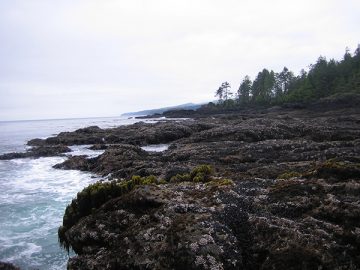 | 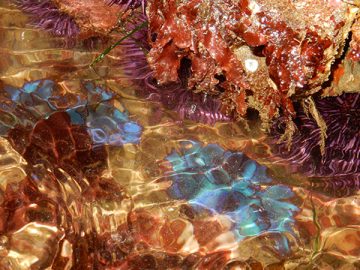 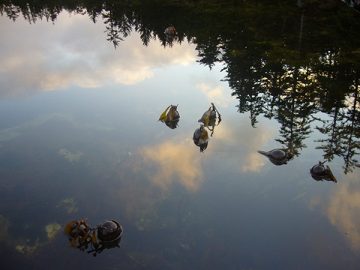 |